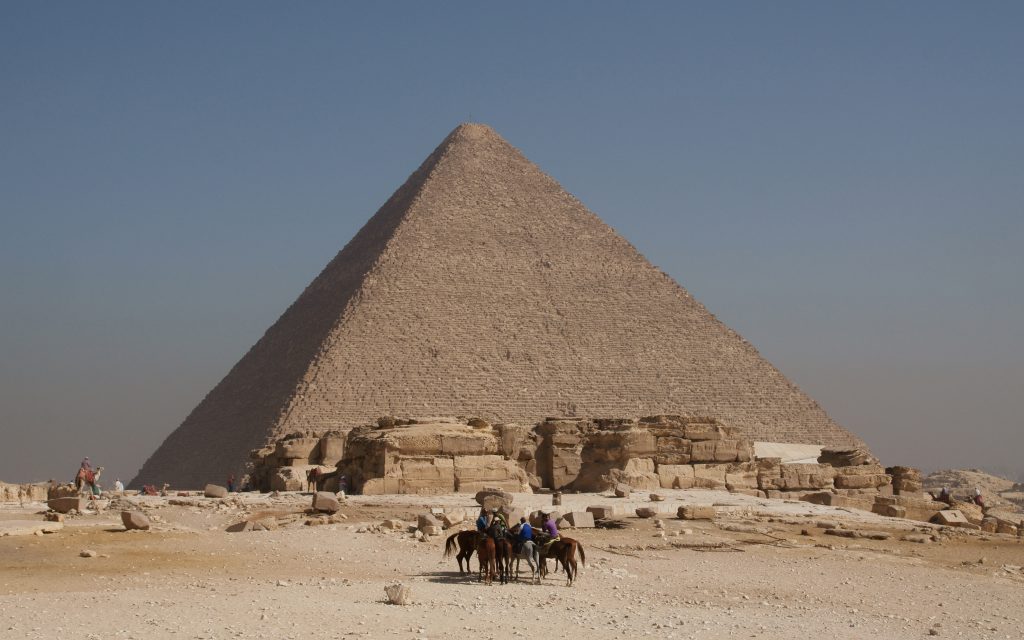The construction of the Great Pyramid of Giza has been a great mystery for many centuries. Recently, archaeologists believe that they have found evidence that suggests that it was not slaves, under the order of King Khufu, who were responsible for building the pyramid. With the discovery of nearby mastabas, there is now substantial evidence suggesting that normal villagers would periodically help construct the Great Pyramid, and they were motivated by their religious beliefs.1
King Khufu is considered one of the greatest rulers of his time, largely due to the elaborate pyramid he was able to create during his lifetime. He was known as a cruel and tyrannical leader, but was evidently powerful by being able to gather a large workforce and enough materials to construct the Great Pyramid, most of which is still intact today. According to Greek historian Herodotus, there had been around one hundred thousand slaves working through King Khufu’s reign. This was proved false in 1990 when the archaeologist Zahi Hawass discovered a town of mastabas near Giza.

These mastabas were rectangular mounds made of mud bricks. Eventually, they would stack some of them together to form pyramids, giving them the idea of the modern pyramid. The findings of many mastabas suggests that the workers were not slaves but were actually compensated in some form for their labor. They also discovered two miniature pyramids that held the remains of officials, such as supervisors, technicians, and craftsmen on the upper level, and other laborers on the lower level.2 The workforce consisted mainly of peasant farmers who would work during the fall and winter seasons. During that time period they were unable to work on their farms due to the seasonal overflow of the Nile River. This gave them an opportunity to continue working throughout the year. It was also a great way for the peasant farmers to get food, clothing, and shelter.3 Some laborers took part in a group called a phyle, which was a rotating group of workers who would work for a month. The king would collect surplus crops as well as other clothing to distribute to these workers, which he levied as a form of tax. Egyptologist such as Zahi Hawass and Mark Lehner now estimate that only about twenty to thirty thousand men were needed to build the Great Pyramid.
The construction of the pyramid was a communal project in which all Egyptians took part, including women as well as men. At the time, there were no machines or animals to help carry the loads of limestone and granite to the pyramids.4 Every block was handmade and crafted to fit perfectly alongside the other pieces. They cared greatly in their work and took pride in their accomplishments. Not only were they building the burial site for their king, but they were also taking part in the construction of a new and elaborate Egypt.
During Egypt’s Old Kingdom, when these pyramids were built, the kings were associated religiously to gods. They were seen as the living manifestation of the god Horus, the god of the sky. The god Horus was also the son of Osiris, who was the king of the underworld. Once the king would pass away he would become one with Horus.5 This helped motivate the laborers to continue building the pyramids. Most Egyptians at that time were very religious and spent their life preparing for what would come after death. They believed that by building the pyramid for their king, a descendant of Osiris, they would assure both their king and themselves a good afterlife. Because of this, they did not see their work as a continuous strain, but rather viewed it as an honor.
Overall, it was a very organized and coherent system that allowed everyone to partake in. It was beneficial not only to King Khufu, but to the entire Egyptian society as well. Jobs were created and many peasants received benefits of clothing and shelter from the enterprise. It united the Egyptian civilization and created magnificent pyramids that we can still visit today.
- Mastabas are burial mounds that were used to bury rulers and pharaohs, which later gave way to the idea of a pyramid. See Global Events : Milestone Events throughout History, Vol 1. Africa, Jennifer Stock, ed. (Detroit : Gale, Cengage Learning, 2014., 2014), 12. ↵
- Global Events : Milestone Events throughout History, Vol 1. Africa, Jennifer Stock, ed. (Detroit : Gale, Cengage Learning, 2014., 2014), 18. ↵
- The Oxford Companion to Archaeology (2 ed.), 2012, s.v. “Pyramids of Giza,” by Edward Bleiberg. ↵
- The Oxford Companion to Archaeology (2 ed.), 2012, s.v. “Pyramids of Giza,” by Edward Bleiberg. ↵
- Funk & Wagnalls New World Encyclopedia, 2016, s.v. “Horus”. ↵



87 comments
Emily Velazquez
I think that it is great that new evidence has emerged on how the Pyramids may have been built. Reason being is because there are so many questions about who actually did build these fascinating monuments- even the possibility of Aliens building them! I believe that we should continue to research how they were built to learn from their architectural understandings and impressive, longstanding monuments.
Diego Terrazas
I wonder if the citizens who help build this pyramid were hoping that they would be blessed by the gods if they helped built the monuments. The effort put into building such large monuments in an ancient time which such carefulness is fascinating. I cannot help but wonder if partaking in this project as a citizen was mandatory or perhaps they did it to please the gods.
Abigail Lopez
I was unaware that many people willingly took part in helping construct the pyramid of Giza and how much effort was put into each mastaba. I find it fascinating that every brick was made to perfectly fit one another. Also knowing that many came together to build such a grand pyramid makes it more meaningful being that everyone showed unity through their work because of their religion.
Katherine Wolf
It is amazing to think that just a human workforce could build something so grandiose and awe inspiring. I was always under the impression that slaves and prisoners of war were forced to build those monuments. I am glad to be enlightened to the fact that, instead of forced labor, it was a source of national and religious pride for those that built it. I think the fact that it was built willingly and out of love for something greater than themselves adds more weight to the impressiveness of the pyramids.
Kacey Diaz
After reading this article I have a better idea of how the pyramids were built. I’ve actually been to Egypt and have seen the pyramids and it’s really amazing to see in person and to see how big the stones that were used to build the pyramids actually are. After seeing them and reading this article, I can’t help but to be amazed that the ancient Egyptians were able to accomplish such an amazing thing.
Jose Fernandez
This is a very interesting article! Even though everyone knows the pyramid of Giza, not many people know about its creation and purpose. I always thought all the pyramids in Egypt were constructed by slaves. It was surprising to find out that this one didn’t. I think this is a really incredible construction, and I hope I have the opportunity to visit it one day. I really enjoyed the article. Even though it is short, the author makes a great job presenting the topic.
Donte Joseph
As crazy as it sounds, because of many people’s unpopular opinion that aliens created the pyramids, I started to believe it too. Thanks to this article, I now have a better idea of how the pyramids came to be instead of the “many people did this” claim I had been taught for years. Reading how hard the villagers worked toward their goal of finishing the pyramid is tiring in itself, but their hard work did not go unnoticed.
John Smith
The Great Pyramid of Giza is incredible because not only is it a great wonder, it’s a great wonder that we still actually have around today. It’s crazy to think about the amount of work the Egyptian people had to put in to build the Great Pyramid and although it’s construction is still a somewhat mysterious subject to this day, I’m just glad it wasn’t aliens that built this wonder to last.
Christopher Hohman
Nice article. The great pyramids really are quite extraordinary. The men and women who built them must have been extraordinarily proud of their work. And they had every right to be. Those structures are still intact today, perhaps not as glorious as they once were, but they are still here. It is funny how the Egyptians worried about the afterlife kind of like many of us do today. For them constructing these structures was something were proud to do
Lynsey Mott
Learning about how they built the pyramids was a real eye opener! To think that people actually thinks it was aliens that had built them instead of humans is a really weird concept. So knowing that they didn’t build these relics with super fancy technology, and slaves were actually the ones to build these are actually pretty cool and I bet once they were done with one pyramid they were proud of themselves knowing that not only did they accomplish building the pyramid but they had to know that these pyramids will be there for the rest of the world to see in the future.